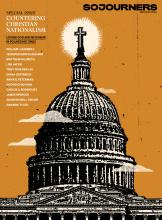WE STOOD AT the base of a sticky, bright mountain, a 50-foot-high altar of hay and clay and thousands of gallons of paint proclaiming “GOD IS LOVE” in chunky letters. We shaded our faces from the hazy-sizzling sky to see the white cross at the very top, blue stripes streaming down the sides, a parade of happy flowers at the base. “Say Jesus I’m a sinner please come upon my body and into my heart” is written into a giant cherry-red heart.
My friends and I were 19 years old and seeing Salvation Mountain, the folk-art stronghold, for the first time. We learned about Salvation Mountain the way most people do these days: through friends on Instagram. We drove three hours east from San Diego to Niland, a tiny census designated place in Southern California’s Imperial Valley, a desert landscape of sagebrush, sand, and brassy wind. Salvation Mountain’s artist, Leonard Knight, began building the mountain in 1984 and maintained it every day until his health began to fail in 2011. He died in 2014.
The prayer in the big red heart was what Knight prayed on the day he experienced a born-again moment and heard God call him to build a mountain proclaiming universal love to the world. When we visited, he’d been dead for a few years, and the mountain was getting cracked and worn, the paint tearing up in chunks. Knight built other structures next to the mountain, including a shaded “forest” of what he called “car tire trees”: stacks of tires for trunks and crisscrossed poles for branches, mixed with adobe and straw and painted bright colors. We quietly moved among them. “God is love” appeared again and again on the crevices and lumps, like a psalm. I felt it in my chest, that ache it takes to devote all of one’s creativity and being to God.
Read the Full Article

